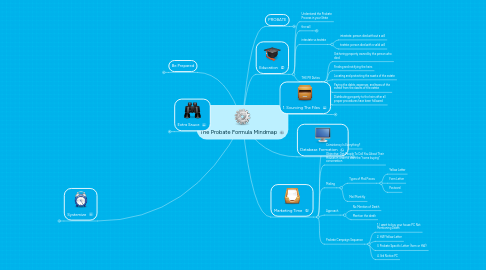
1. Extra Sauce
1.1. Tax Delinquent
1.2. Cold Calling
1.3. Really Solid Areas
2. Systemize
2.1. Document your whole process
2.1.1. Where did you get the list
2.1.2. How long on average does it take?
2.1.3. How often did you go?
2.1.4. Whats the ration of files to files with property?
2.2. Hire somebody Competent
2.2.1. Place ad on Craigslist
2.2.2. Send application to people who respond
2.2.3. Phone interview 2-3 people
2.2.4. Hire who you feel confident With
2.2.5. Take one trip with them so they fully understand the process
3. Be Prepared
3.1. feuding family members
3.2. be sympathetic
3.3. be the probate guy/gal
3.4. Be Able to Explain Probate Process
3.5. stay away from the death
4. Education
4.1. Understand the Probate Process in your State
4.2. the will
4.2.1. A will is the legal instrument that permits a person, the testator, to make decisions on how his estate will be managed and distributed after his death
4.2.2. the probate process starts with the will being validated by the court/probate office
4.3. intestate vs testate
4.3.1. intestate: person died without a will
4.3.2. testate: person died with a valid will
4.4. THE PR Duties
4.4.1. Gathering property owned by the person who died
4.4.2. Finding and notifying the heirs
4.4.3. Locating and protecting the assets of the estate
4.4.4. Paying the debts, expenses, and taxes of the estate from the assets of the estate
4.4.5. Distributing property to the heirs after all proper procedures have been followed
5. 1. Sourcing The Files
5.1. City Hall/Court House
5.1.1. Google "your city" Register of Will office
5.1.2. Call ahead to find out what the process is for pulling files
5.1.3. Schedule a long window to go down there
5.1.4. Get a feel for their filing system works
5.1.4.1. Manual Pull
5.1.4.2. Computer?
5.1.4.3. Request form?
5.1.4.4. Online
5.1.5. Locate the File Room
5.1.6. City Workers are underpaid>>>>>Be Persitant
5.2. The Files/Documents
5.2.1. Petition for Probate
5.2.2. Oath of Personal Representative
5.2.3. Letters Testamentry
5.2.3.1. document issued by the court clerk which states the authority of the executor of an estate of a person who has died. It is issued during probate of the estate as soon as the court approves the appointment of the executor named in the will
5.2.4. Letters Of Administration
5.2.4.1. where the decedent has left no will or the executor named in a will is unable or unwilling to serve, the courts must appoint an administrator. This appointment is made by issuing a short document called letters of administration, which is a decree that serves as evidence of the administrator's authority
5.3. Pertinent Info
5.3.1. 1. Is there property attached?
5.3.2. 2. Personal Representative
5.3.3. 3. PR mailing info
5.3.4. 4. Subject Property
5.3.5. File #
5.4. Start Compiling
5.4.1. Move Forward
5.4.2. Work Backwards
5.4.3. How fast can you build the list
5.5. Repetition=Habit
5.5.1. Set a hardcore probate schedule and stick to it!
6. Database Formation
6.1. Turn your paper digital
6.1.1. Transfer info into Excel Database
6.1.2. Seperate list into Months
6.1.3. Creating a Mailable System For Marketing Purposes
7. Marketing Time
7.1. Consistency Is Everything!!
7.2. Objective: Get People To Call You About Their Houses in order to start the "home buying" conversation
7.3. Mailing
7.3.1. Types of Mail Pieces
7.3.1.1. Yellow Letter
7.3.1.2. Form Letter
7.3.1.3. Postcard
7.3.2. Mail Monthly
7.4. Approach
7.4.1. No Mention of Death
7.4.2. Mention the death
7.5. Probate Campaign Sequence
7.5.1. 1. I want to buy your house PC Not Mentioning Death
7.5.2. 2. HW Yellow Letter
7.5.3. 3. Probate Specific Letter (form or HW)
7.5.4. 4. 3rd Notice PC
8. PROBATE
8.1. WHO
8.1.1. The Decedent
8.1.2. The Personal Representative
8.1.2.1. a personal representative is required to administer the decedent's estate, which involves resolving any debts and handling the distribution of property
8.1.3. Beneficiaries
8.1.3.1. a person designated as the recipient of funds or other property under a will
8.2. WHAT
8.2.1. Estate Administration
8.2.1.1. When an individual dies, it is often necessary to follow formal procedures in settling the estate. This process is called ESTATE ADMINISTRATION. Both state and federal law establish certain requirements which must be followed.
8.2.1.2. The word ESTATE is used to describe the property and obligations of a person who has died. ADMINISTRATION includes procedures and requirements relating to collecting of assets, satisfying of obligations such as debts, expenses and taxes, and distributing property to the heirs and beneficiaries.
8.3. WHERE
8.3.1. The County in Which The Property Resides
